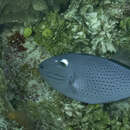Diagnostic Description
provided by Fishbase
Three prominent diagonal grooves running from below and behind mouth nearly to gill opening; light brownish gray with rows of dark brown spots on body; grooves on head dark brown; caudal fin pale with orange-red upper and lower borders and a large orange-red crescent posteriorly (Ref. 13442).
- Recorder
- Grace Tolentino Pablico
Morphology
provided by Fishbase
Dorsal spines (total): 3; Dorsal soft rays (total): 26 - 29; Analsoft rays: 23 - 27
- Recorder
- Grace Tolentino Pablico
Trophic Strategy
provided by Fishbase
Aggregates in the water column during the day to feed on plankton. At night, it seeks shelter in reef crevices where it stays until morning (Ref. 13550). Inhabits seaward reef slopes, usually well below 30 m, where in some places they are among the most common fish. Young live among floating Sargassum. Solitary or in small groups. Feeds on crabs and sea urchins.
Biology
provided by Fishbase
Inhabits seaward reef slopes, usually well below 30 m, where in some places they are among the most common fish. Young live among floating Sargassum. Solitary or in small groups. Feeds on crabs and sea urchins. Spawns in deep water (Ref. 9710).
Importance
provided by Fishbase
fisheries: minor commercial; aquarium: commercial; price category: medium; price reliability: very questionable: based on ex-vessel price for species in this family

